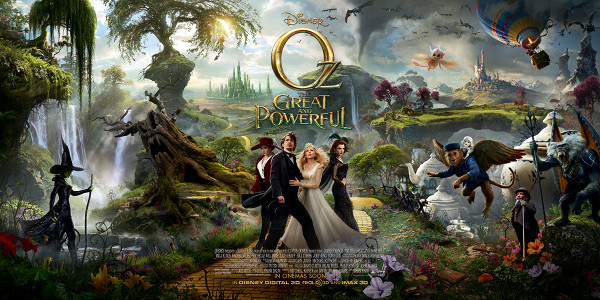
Tim: Disney’s no stranger to the magical sandbox that is L. Frank Baum’s Oz. Considering they had every intention of following up Snow White & the Seven Dwarves with an animated adaptation of Baum’s tome, Oz the Great & Powerful represents another of their attempts to roll the universally recognized imagery of emerald cities and yellow brick roads into their Magic Kingdom. And where they failed spectacularly at doing just that with 1985’s Return to Oz, they brought out the big guns for this latest effort – throwing into it A-list stars, the budget of a small country and one of geekdom’s most beloved filmmakers.
You have to respect the balls on Sam Raimi. Disney can hide behind the public domain status of Baum’s series all they like, Raimi is very much making a film steeped in some of cinema’s most powerful iconography. Few films are as recognized and celebrated as MGM’s 1939 adaptation, and Oz the Great & Powerful resides steadfastly in prequel territory. From a black and white 4:3 open that transforms into breathtaking 16:9 color, Raimi is very much the visual master we’ve long heralded, even as he makes what was for me an extremely frustrating choice with his use of 3D from the film’s beginning.
The past several years have seen the masters try their hand at painting with the 3D brush. Like those before him, Raimi logs both successes and failures. We’ll get to visuals in due time. First and foremost, Raimi needs to tell a story that makes this return trip to Oz worthwhile.
The question I pose to Josh: does the script accomplish this lofty feat?
Josh: I guess it depends on how you look at it. As a prequel to what might be the most famous film of all time (if we factor in its age and the stamina of its cultural relevance and iconography), it is hard not to see Oz the Great & Powerful as a lame easy-money grab, if not something of a small sacrilege. But if we acknowledge the fact that Baum wrote a whopping thirteen sequels to his book, that several Oz adaptions had already been made prior to the famous 1939 The Wizard of Oz, that countless film and TV re-visitations came and went after Judy Garland clicked her slippers together, and yet how few of those other projects even attempted to match the scope of the MGM classic, then Sam Raimi’s film starts to look far less offensive. Worthwhile? Creatively; maybe not. Of your viewing time; yeah why not. Especially if you have kids.
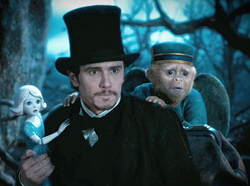 I will cop to the fact that I walked into Oz the Great & Powerful with an attitude. In our post-Phantom Menace world I’ve developed something of a disdain for the whole idea of prequels. I don’t care how the Wizard became the Wizard, or why the Wicked Witch is so wicked. These were never questions I asked myself as a child watching the Garland film. So seeing Oscar Diggs’ (James Franco) basically repeating Dorothy’s journey to Oz, complete with a sepia-toned tornado, and being instrumental in the wickedifying of a certain witch, seemed boring as hell to me. But I should have learned by now never to write off Sam Raimi beforehand. I quite enjoyed Oz the Great & Powerful when I was done watching it several weeks ago. It is generic praise to call a film “fun,” but that is usually the word that comes to mind when talking about Sam Raimi. Few do fun quiet as discerningly as Raimi does it. But I think it also deserves to be said that I’ve found myself thinking about the film very little since I saw it. It is a well made film, but it has a certain ’empty calories’ aspect to its tastiness.
I will cop to the fact that I walked into Oz the Great & Powerful with an attitude. In our post-Phantom Menace world I’ve developed something of a disdain for the whole idea of prequels. I don’t care how the Wizard became the Wizard, or why the Wicked Witch is so wicked. These were never questions I asked myself as a child watching the Garland film. So seeing Oscar Diggs’ (James Franco) basically repeating Dorothy’s journey to Oz, complete with a sepia-toned tornado, and being instrumental in the wickedifying of a certain witch, seemed boring as hell to me. But I should have learned by now never to write off Sam Raimi beforehand. I quite enjoyed Oz the Great & Powerful when I was done watching it several weeks ago. It is generic praise to call a film “fun,” but that is usually the word that comes to mind when talking about Sam Raimi. Few do fun quiet as discerningly as Raimi does it. But I think it also deserves to be said that I’ve found myself thinking about the film very little since I saw it. It is a well made film, but it has a certain ’empty calories’ aspect to its tastiness.
Tim: Is Oz the Great & Powerful a bad film? No. But is it a good Sam Raimi film? That’s a more difficult question to answer. This is definitely a film in which enjoyment is predicated on one’s acceptance of taking the good with the bad. I wholeheartedly second your notion about prequels. Like many a prequel, Oz is at its most arduous when it’s working to put the recognizable pieces into place. Without going too heavily into spoilers, it’s a large part of why Mila Kunis worked for me not at all. Her Theodora is an astoundingly poorly written and executed character – her investment in Franco’s character is downright comical at times. It’s classic Star Wars prequel schlock, where a character’s transition is hindered, not helped, by our preconceived notions.
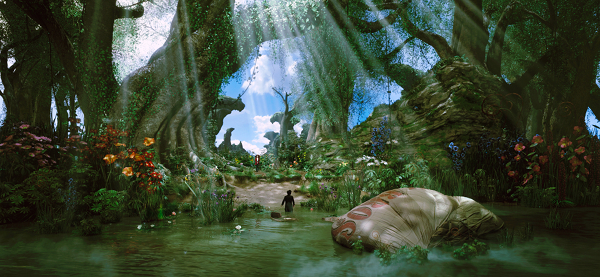
That may be true for many of the characters in the film, actually. When you consider the romantic compotent, particularly between Oz and Glinda (Michelle Williams) you start to think “Well that wasn’t in the original film.” Nor should it have been, but it’s an interesting barometer of where Hollywood’s collective head is at these days. When the inevitable Wizard of Oz remake comes to fruition, which one of her three companions is most likely to serve as a romantic interest? That whole aspect feels suspect – there only because of the misguided perception that it has to be.
Under scrutiny the film threatens to fall apart, and leaving the theatre I wasn’t quite sure how I felt about the whole. If Oz is a failure, which I believe it to be, it’s also a noble one; perhaps rewardingly so. If anything, I thought about how bad this makes Bryan Singer look. Two filmmakers attempting to accomplish much the same, with similar technological advantages, and Jack the Giant Slayer couldn’t have misfired more completely. Then you factor in what Raimi accomplishes with Oz, the way his actors interact in the digital landscape, the immersive 3D visuals that frame Oz as a lush extension of our own imaginations, and you begin to realize that categorizing Oz a bad film is to not take into account many of the bad films we’ve seen this year. So, while we’re likely to start picking it apart piece by piece, be mindful that Josh is indeed correct when he says Oz is great fun.
Josh: Let the picking begin! Mila Kunis, as much as I have liked her in the past (particularly Forgetting Sarah Marshall), feels miscast in the film — or at least wasted on a character she just isn’t right for. I agree with you, the way that Theodora falls so head over heels for Oscar doesn’t sit right. I’m sure it will be fine for kids, and I’m also sure we’re supposed to accept it because Oz is a magical land where things work differently. But considering all the important plot developments that hinge on Theodora’s infatuation, the character comes off as flimsy and two dimensional. And again, Kunis isn’t really the actress to right that ship. Though, while we’re on the subject, I felt like all three of the female leads were poorly written. Well, “poorly written” maybe isn’t the right way to put it. I’d lean more towards “under written.” Oz is very old-fashioned in its storytelling goals, which is fine and I’m sure was intentional on Raimi’s part as he tried to match the aesthetic of the 1939 film. But here in 2013, considering that Oz is about a caddish male mixing up the lives of three women, the film has a certain “bitches be crazy” element to it.
I wouldn’t categorize it as offensive or misogynistic. But then again it’s not really my place to make that call.
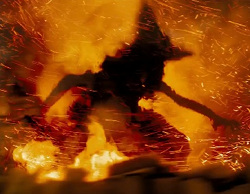 Tim: People attacking the film from that angle, accusing it of misogynistic overtones, will certainly have plenty of ammo. The fact that these women’s hopes rest on a prophecy that a man will come to fix everything is poor form. But, as you suggested, I want to be careful not to confuse poor writing with more sinister motives. It’s true that, in addition to being woefully miscast, Ms. Kunis suffers the brunt of the bad writing. There’s a scene where, upon hearing Glinda voice her belief in Franco’s character, Theodora exclaims “I once believed in him too!” It shouldn’t come off so clunky, but when you take into account how little time Kunis and Franco spend together in this film, it’s a joke with an unintentional punchline.
Tim: People attacking the film from that angle, accusing it of misogynistic overtones, will certainly have plenty of ammo. The fact that these women’s hopes rest on a prophecy that a man will come to fix everything is poor form. But, as you suggested, I want to be careful not to confuse poor writing with more sinister motives. It’s true that, in addition to being woefully miscast, Ms. Kunis suffers the brunt of the bad writing. There’s a scene where, upon hearing Glinda voice her belief in Franco’s character, Theodora exclaims “I once believed in him too!” It shouldn’t come off so clunky, but when you take into account how little time Kunis and Franco spend together in this film, it’s a joke with an unintentional punchline.
I too enjoy Kunis as a performer, but her career straddles a line that wasn’t ready for the chutzpuh a role like this necessitates. Is Kunis an actor? A star? Both? I’d say she’s star first, though her potential as an actor is promising. But you’re correct that she’s all wrong for this. From her voice to her look and attitude when she finally gets to where she’s going: she’s out of place.
So too is James Franco, an actor who’s never done his best work under Raimi. His Oscar, a lothario magician who finds himself displaced in another world, Franco shines in moments and falters in others. It contextualizes his larger inconsistency in film. He strikes me as an actor that’s unable or unwilling to engage when he’s disinterested. His performance largely mirrors Kunis, furthering the unintentional out-of-placeness in a film that’s ironically about a man displaced. When Zach Braff gives the finest performance of the film, as a winged CG monkey no less, you have to wonder.
Josh: Please don’t remind me of Franco’s performance in the Spider Man sequels. I didn’t really have a problem with him in Oz, but Franco’s naturalistic talents (still best showcased on Freaks & Geeks) have always and apparently will always meet with some friction when they encounter Raimi’s signature stylized tone — a tone that Bruce Campbell of course always nails when he pops in for his essential cameo (seen here as a flustered and abused Winkie guard). Franco is SO much better here than in Spider Man 2 and 3, but I also can’t discount what you’re saying. Franco can at times seem like he’s just going through the motions in certain scenes. Which makes Raimi’s apparent fondness for the actor a little perplexing. I’m not going to be that fanboy that says, “Bruce Campbell should have starred in this film!” Cause, honestly, he shouldn’t have. But given the similarities between Oz and Army of Darkness, just imagining a young Campbell as Oscar Biggs suddenly creates a much more successful and lively film in my mind. Franco has personality. I like him. But he can’t carry this kind of film. Not for lack of talent. Just cause he isn’t a Raimi-style performer, despite how many Raimi films he’s appeared in. When he’s allowed to play Oscar as a smirking shit, it works. But when he needs to sell the heartfelt cheese, it doesn’t. Actors like J.K. Simmons and Alfred Molina can deliver both the A-lister drama and the requisite Raimi hamminess.
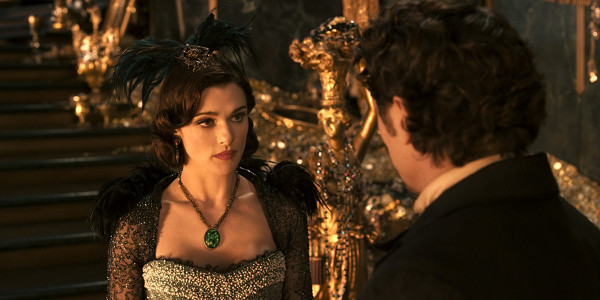
Call it weak writing, or whatever, but one thing you and I keep coming back to here is that this is a script that can only stand up to a child’s scrutiny. This is a movie going for simple ideas, told with simple broad strokes. So it isn’t so much that Franco’s performance is bad, but just not broad enough. Judy Garland was so big and wide-eyed that she sold us the Land of Oz, without Dorothy needing to constantly be flipping her shit over everything she sees. James Franco subverts the craziness, which maybe could have been novel 10 years ago. But with audiences so thoroughly used to FX spectacles now, I don’t know that down-playing the awe-factor is a wise idea.
Tim: It’s true that Franco seems oblivious to his fantastical surroundings. Those surroundings have thankfully been painted with an illustrious brush. The digital projection is immaculate, the 3D immersive and the magical land of Oz splayed out in a lush landscapes of beauteous fauna and colorful communities. Nothing about this Oz looks real, yet that’s sort of the point isn’t it? This is an effects laden work that is more animated than live action. Many a scene takes place in front of a digital matte painting, and even the interiors feel largely digital. But this is an instance where the non-practical works well enough. The quality and presentation of the effects are rooted in Raimi’s deeply imaginative pallatte and absolutely suit the film.
My biggest gripe is one that’ll probably be of little to no concern to most who see the film: 3D 4:3. Raimi’s film begins much the way the 1939 film does in black and white. Raimi takes it a step further and presents it in the 4:3 aspect ratio, moving to full 16:9 only when we land in Oz. But it’s jarring to see a sequence framed like that in 3D, betraying the entire notion of its inclusion and sacrificing what would’ve been a much more gratifying visual transition into Oz.
Josh: It does seem like a logical update on the old B&W-to-color transition, to go 2D-to-3D once we hit Oz. Raimi plays his own game, having objects bust free from the 4:3 frame into the widescreen nothingness now and then, but it was a missed opportunity to give young audiences something in the same vein as the 1939 film. Not that 3D is at all novel anymore, but the moment you see B&W here, it is just a gimmick itself. Suddenly transitioning into color is meaningless, because color has been the norm for the past five decades. It’s actually more interesting to have stuff in B&W. So the whole aesthetic shift is kind of valueless, and purely fan-service to the MGM film. Which is fine. But “fine” isn’t gonna keep people watching Oz the Great & Powerful seventy years from now.
I guess maybe the most telling thing about this film is how little I feel inspired to say about it all these weeks later. I had a nice time watching the movie. There are moments when the visuals are truly impressive, and Raimi and company do manage to work in some inspired new ideas — like China Town, a city made entirely out of precious china, as in porcelain. And the scene in China Town when Oscar fixes a broken China Girl (voiced by Joey King) uses Earth glue is one of Oscar’s more genuine interesting hero moments — but the movie lacks any real specialness. Or maybe I’m too old and too familiar with the 1939 film for Oz the Great & Powerful to work on me. Normally I would never criticize a movie for not being iconic. But when you’re intentionally bonding your film with a cinema classic that is the very definition of iconic, you’re kind of asking for it.
Rating: 




Out of a Possible 5 Stars
Tim: I keep coming back to the fact that middling Raimi is not the same as a middling film. Guy’s a master and, for all the film’s failures, it’s certainly given us a lot to (sewer) chew on. This is a film I’ll be revisiting if only for the opportunity to take in the visual experience a second time. We bring up misogyny and while it’s obviously not the film’s primary intention, it’s an interesting and unfortunately accurate way of reading into the proceedings – unintentional though it may be.
You take the good with the bad in a film like this, one that’s deserving of neither your adulation nor your scorn. Sometimes films really are just okay, impervious to a complete tear down and underserving of high praise. I liked Oz the Great & Powerful, I just can’t bring myself to loving it.
Rating: 




Out of a Possible 5 Stars